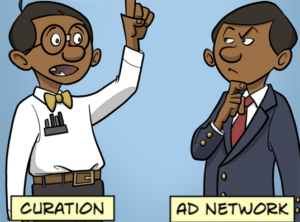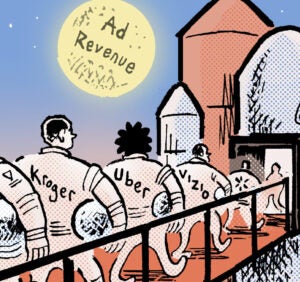 Here’s today’s AdExchanger.com news round-up… Want it by email? Sign-up here.
Here’s today’s AdExchanger.com news round-up… Want it by email? Sign-up here.
Measuring ‘Walk-Throughs’
PlaceIQ is offering a new metric for mobile ads that’s essentially a real-world equivalent of the online “view-through.” The so-called “Place Visit Rate” is defined thusly: “The ratio of people who viewed mobile ads for a physical retailer and subsequently were observed in that store.” Blog post. AdAge notes that Starcom MediaVest Group is offering it to retail clients. More.
The Multichannel Challenge
The good news is internet traffic from smart TVs and set top boxes is rising alongside traffic from tablets and smartphones. The bad news is companies must work even harder to reach consumers, reports Broadband TV News, which cites findings from the Netbiscuits quarterly web trends report. “This evidence creates a serious challenge for brands, as more devices come in numerous different technologies, sizes and configurations. Without adopting a fully future-proofed multi-channel approach, companies risk falling behind and ultimately wasting money and losing consumers,” said Netbiscuits CEO Michael Neidhoefer. More.
Google Misbehaving
Google is once again on the privacy hot seat—this time for failing to meet requests by taskforces in France, Germany, Italy, the Netherlands, Spain, and the United Kingdom to modify its privacy policy. The result, observes All Things D’s Liz Gannes is “additional investigations and inspections by the Europeans, but this time they’re being called ‘enforcement actions’ and they’re being conducted by each country individually.” Over at the Verge, Aaron Souppouris notes that Google could face fines levied by each country. Read the CNIL’s press release.
Local Yokel
Are there fumes left to burn in the local ad network gas tank? Local.com apparently thinks so, having launched a new “premium” network of newspaper sites and other locally focused properties to capture national ad spend. Greg Sterling notes on his Screenwerk blog, “This is almost exactly the same value proposition of the former Real Cities, which was owned by McClatchy, Gannett and Tribune Co. and was one of the first attempts at a national-local premium ad network.” Centro bought and eventually shut down Real Cities. Unrelated but related: the sails also seem to have gone slack in Yahoo’s Newspaper Consortium. More.
NYT Friendly Takeover
The NYTimes.com has long been trumpeting its custom homepage ads as a solution to the problem of attracting brand advertising akin to the expensive ads in its daily newspaper and weekly Sunday magazine. The latest is a front-page ad takeover for insurer Prudential that lets users see an image of NYT front page of the day they were born, which caught the eye of Adweek’s Lucia Moses. “While the Times has been praised for taking an innovative approach to advertising—especially for such a traditional publication—these kinds of initiatives may well invite backlash from editorial purists who would bristle at the mingling of editorial and advertising,” she opines. Read more. Interestingly, the image can be shared on Twitter and LinkedIn, but not Facebook.
SinglePlatform Gets Yelped
Unlike politics, all online advertising isn’t local, but proximity is important for certain publishers. Take reviews site Yelp, for example, which has signed on with business listings publisher network — and Constant Contact acquisition — SinglePlatform. “We didn’t feel like we were quite ready yet with our publisher network, and our business wasn’t quite ready to scale,” Wiley Cerilli, SP’s founder and now-VP at Constant Contact, told Street Fight’s Steven Jacobs. “But you’re going to start to see a lot more combined marketing efforts from the two companies.” Read more.
Stop Going Native
The Drift’s Doug Weaver has already said it’s time for the ad industry to eschew the term “programmatic.” Now, he thinks it’s time to clean house and stop using the term “native advertising” as well. “Everything from ‘product placement’ to sponsored tweets to ‘anything that’s not a banner’ has been unceremoniously dumped in the Native Advertising hopper… Yes, it’s definitely time to click on ‘Empty Native Advertising Bin’ and start over,” Weaver writes. Read more.
You’re Hired!
- Webbys Master Neil Vogel Is About.com’s New CEO – AllThingsD
But Wait. There’s More!
- Ads Manager: Making it Easier to Track Campaign Performance – Facebook Studio blog
- New Quality Online ‘Newspaper’ Without Ads Planned For Dutch Market – The Irish Times
- China’s Largest DSP iPinYou Is Selected As The First To Integrate With Sina Ad Exchange (SAX) – press release
- Does Sponsored Content Have a Labeling Problem? – Digiday
- Deeper Transparency & Control For Publishers In AdX – DoubleClick Publisher Blog
- Moontoast And Kenshoo Social Partner To Power Rich Media Social Advertising Campaigns Directly In Facebook News Feed – press release













